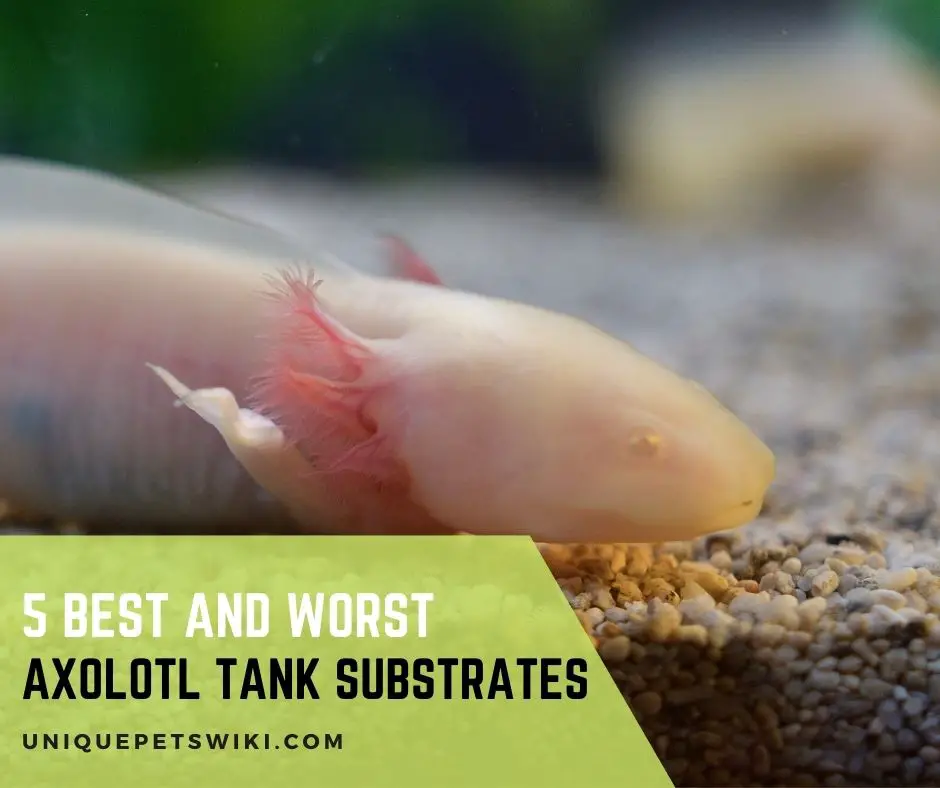When it comes to setting up a tank for your axolotl, choosing the right substrate is one of the most important considerations.
What you put on the bottom of the tank largely determines the health and well-being of your axolotl.
Many axolotl owners end up choosing inappropriate materials for substrates and thus make the tank uncomfortable and unhealthy for their little friends.
That’s why it’s vital to know what to look for and what to avoid.
In this post, we are going to discuss 5 best and worst axolotl tank substrates. Hopefully we will be able to help you make informed decisions. Keep reading!
Contents
Do Axolotls Need Substrates?
Although axolotls can live in bare-bottom aquariums, substrates can be good for these salamanders.
Bare-bottom aquariums are not adequately comfortable for axolotls because the bottom is slippery and axolotls can’t get a grip.
You can’t put plants in a bare-bottom tank, and the water gets dirty pretty quickly. Besides, an aquarium with no substrate and no plant is visually unappealing.
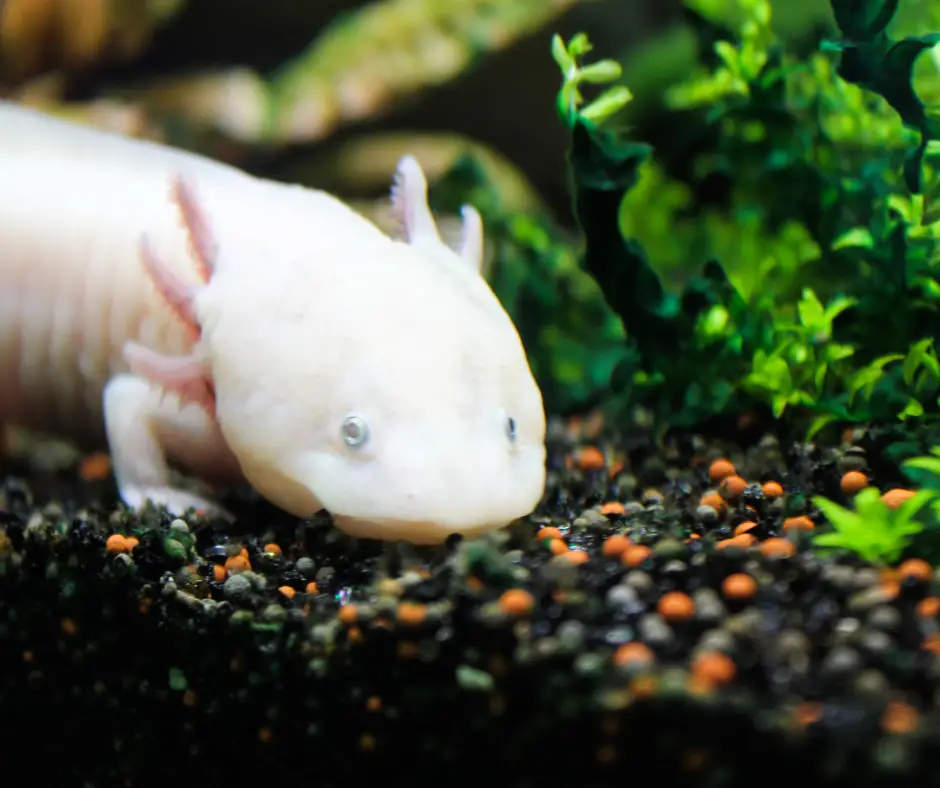
Factors to Consider When Choosing a Substrate for an Axolotl Tank
In order to choose a good substrate for your axolotl’s aquarium, it is important to understand what you should actually look for and why. Here are the factors that should be taken into consideration:
Safety
The substrate you choose for the tank must be safe. Make sure it is not something your axie can swallow.
Even if the animal happens to swallow the substrate, it should be safe. However, it can still cause impaction, which can be deadly for your axolotl.
Make sure it’s non-toxic. It should not contain additional colors.
Comfortable Grip
Choose a type of substrate that provides some grip for your axie. If the material is too coarse, the grip will not be comfortable for your little friend.
So, pick something soft and smooth. Take this factor seriously because a rough substrate can cause significant distress and discomfort for the animal, even injure it.
Effects on the Water Parameters
For an axolotl tank, the ideal pH is 7.4-7.6. It is important to choose a substrate that is pH neutral.
Significant changes in water parameters can severely affect your axolotl’s health. In some cases, inappropriate water parameters can be fatal for your little friend.
Also read: pH for Axolotl and Tips to Maintain
5 Best Substrates for Axolotl Tanks
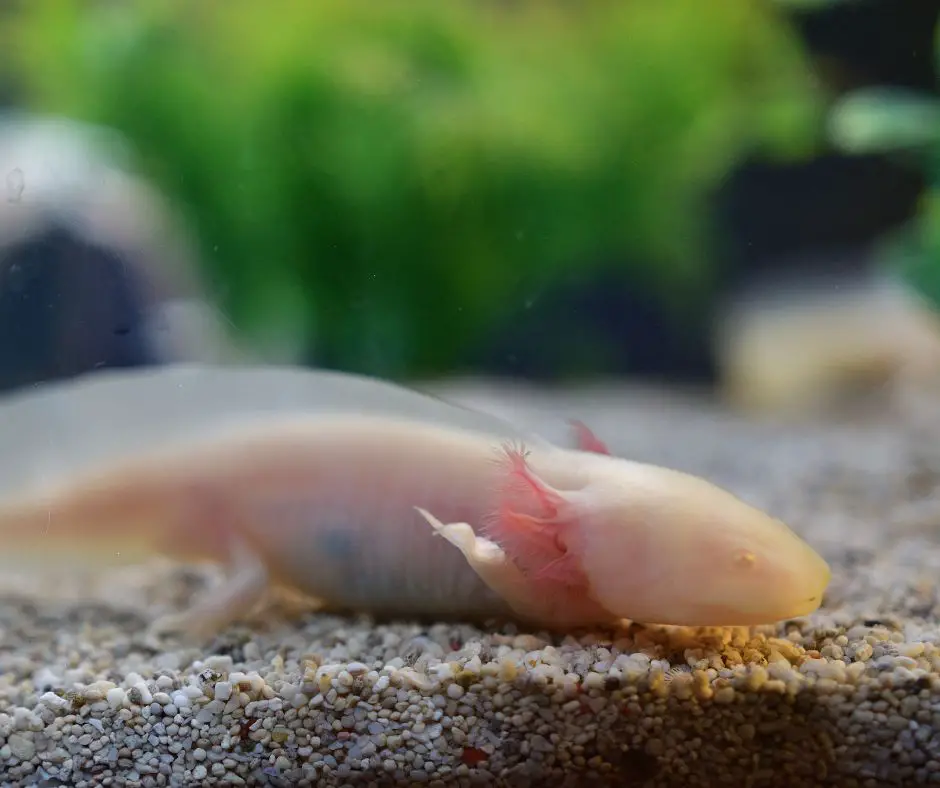
Now we are going to review 5 substrates that work very well with axolotl tanks. When choosing these options, we have considered all relevant factors mentioned above.
Each of them has their advantages and disadvantages, but in general, they are good options.
| Options | Safe | Comfortably Grip | Won’t Change The Water Parameters |
| #1 Sand | Safe for adult axolotls | Yes | Yes |
| #2 Large rocks | Yes | Yes | Yes |
| #3 Tiles | Yes | Provides some grip, but may not be very comfortable | Yes |
| #4 Bare bottom tank | Yes | No | Yes |
| #5 A mixture of substrates | Depends on what substrates are used | Yes | Depends on the type of substrates |
Sand
Sand is the first option for this purpose. It is not only the most affordable option but also the safest.
Even if your axolotl happens to swallow sand, it will not stay in the animal’s body. The animal will be just fine if the swallowed pieces are small.
It is important to note here that sand is suitable as a substrate only if your axolotls are adults, not juveniles. Small axolotls may be unable to excrete the sand.
Sand has necessary nutrients for plants, so you can keep plants in the aquarium.
Sand allows axolotls to move around freely in the tank. Another advantage of sand is that it does not change water parameters in a negative way.
Sand is soft, and therefore axolotls can comfortably grip onto it. This allows your axolotl to roam through the aquarium with ease.
Make sure you avoid construction sand, calcium carbonate, and reptile mats. Also, avoid colored sand because that may affect your axolotl’s well-being.
Below are some sand substrate products that you may be interested in:
- Stoney River White Aquatic Sand Freshwater
- PlaySand Quikrete Sandbox Play Sand
- Caribsea Super Naturals Aquarium Sand,
- Palmetto Poolfilter-50 20# Grade – Formulated for All Residential
Pros and cons of using sand as axolotl tank substrate:
| Pros | Cons |
| – Safe. You axolotl will not suffer if it swallows sand – Makes the aquarium look natural – Axolotls find it easier to move around | – Not good for juvenile axolotls – Hard to clean with a vacuum cleaner – Pockets of air may turn toxic over time |
Also read: 2 Best Aquarium Sand for Axolotl
- Will not affect PH
- Safe for use in freshwater aquariums
- Non-Toxic coating
Last update on 2022-12-29 / Affiliate links / Images from Amazon Product Advertising API
Large Rocks
Why large rocks? Well, if the rocks are smaller than your axolotl’s head, your little friend will swallow them, and that can lead to serious complications. So, choose rocks that are larger than your axolotl’s head.
They will give the tank a natural look, and provide some grip for your axie.
These rocks are pretty expensive, and that’s why covering the entire bottom with them may not be convenient for all axolotls owners.
Large rocks collect debris pretty rapidly, and cleaning them can be tricky. To clean the rocks, you will have to remove them from the aquarium. Another disadvantage is that plants will not grow on these rocks.
Here are some products you may be interested in:
- Fluval Polished Ivory Stone for Aquarium
- Fluval Polished Black Agate Stone for Aquarium
Pros and cons of using large rocks as axolotl tank substrate:
| Pros | Cons |
| – No risk of impaction – Provide comfortable grip – Make the tank look natural and visually appealing | – Pretty expensive – Collect debris and algae – Hard to clean |
- Finely polished earth stones from India
- Elegant decorative feature for freshwater aquariums
- Tumbled stones with smooth, quality finish
- Completely natural
- Safe for fish; Will not adversely affect water chemistry
Last update on 2022-12-29 / Affiliate links / Images from Amazon Product Advertising API
Tiles
Ceramic tiles also make a great substrate for an axolotl tank. If you use tiles, there is actually no risk of impaction.
Tiles can be used in combination with sand or other substrate types. Another great thing about tiles is that they make an aquarium look appealing.
With that said, there are disadvantages of using ceramic tiles as a substrate. Tiles are smooth, and your axolotl is hard grip onto the smooth surface.
Some glazed tiles contain metal salts, which can change water parameters. You may want to invest in Ceramic Tiles for Crafts Coasters.
Pros and cons:
| Pros | Cons |
| – No risk of impaction – Visually appealing – Can be used with other materials | – Some tiles are slippery – Tiles get dirty easily – Plants can’t grow on tiles |
- 12 Ceramic Coaster Tiles Craft Kit - Pixiss Unglazed Ceramic Tiles are perfect for creating your own coasters with alcohol ink (requires glazing first), markers, crayons, acrylic paint, resin and more. Our tiles are specifically designed to be used for arts and crafts with all sides perfectly smooth and with a matte finish.
- High Quality Craft Tiles - Pixiss Coaster Tiles are made of durable ceramic. All sides are smooth unlike our competitors who's tiles are rough and have nubs on the sides and patters on the back.
- Craft Tiles Size - Our tiles are just under 4-inches so they fit in normal coaster holders. Our competitors are 4" to 4 1/4" inches which makes their coasters too big to fit in the average coaster holder. Our tiles are 3 15/16" x 3 15/16" x 1/4".
- Cork Tile Coaster Pads - The set comes with 12 perfectly sizes peal and stick cork pads for the bottom of your tiles and coasters.
- Create - Use alcohol ink (requires glazing first), acrylic paint, markers, resin and more to make your own professional looking coasters. Design, create, decorate and customize your own coasters as gifts for family and friends, for any special holiday or for your home. Tile set makes a great gift for any crafter or hobby enthusiast!
Last update on 2022-12-29 / Affiliate links / Images from Amazon Product Advertising API
Bare Bottom Tank
A substrate is not an essential part of an axolotl tank, so you may not want to add a substrate.
If there is no substrate in the tank, your axolotl will remain safe because it will not end up swallowing something unwanted. Cleaning the tank is super easy if there is no substrate in it. A bare bottom tank is recommended for baby axolotl under 5 inches.
However, your axolotl may find the tank a bit boring. An aquarium without any substrate or plans is not appealing.
The slippery surface may make it hard for your axie to move around. Avoid linoleum, vinyl, or very smooth tiles.
Pros and cons:
| Pros | Cons |
| – Easy to clean – Your axolotl can’t swallow something unwanted | – Plants can’t grow – Gets dirty easily – Slippery, may be uncomfortable for your axolotl |
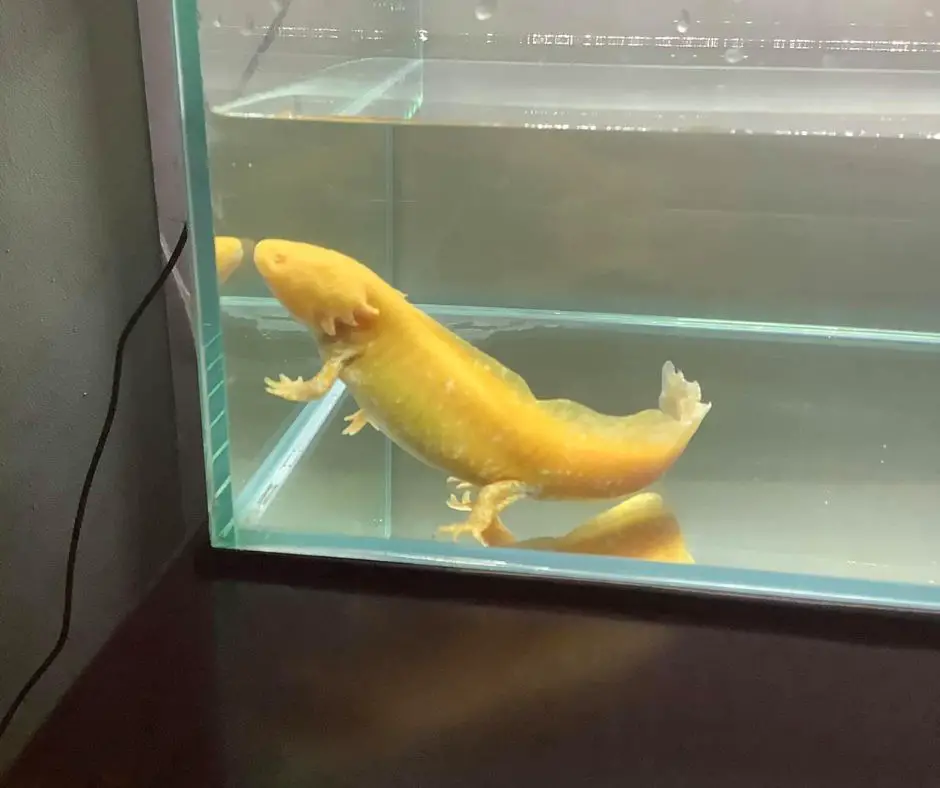
Mix of substrates
You may consider a mixture of two types of substrates. First put a layer of sand and then place some rocks on the sand.
Tile and sand can also be a good combination. Due to the presence of sand, waste cannot get trapped between rocks.
However, a mixture of sand and another type of substrate makes it hard to clean the tank. Bacteria can also accumulate. To prevent it, you may need to stir up the mixture from time to time.
Pros and cons:
| Pros | Cons |
| – Safe for axolotls – Visual appeal | – Bacteria can accumulate between large rocks – Cleanup may not be easy |
Substrates to Avoid for Axolotl Tanks
Axolotls have delicate skin, and that’s why it’s important to avoid sharp substrates such as construction sand, quartz, crushed rock, broken shells, chippings, colored rocks and coral sand.
Do not use any type of gravel, pebble, or small rocks as substrates. Your axolotl will swallow them, and that can lead to impaction. In general, rocks are not a good option.
But if you still want to use them, for whatever reason, pick large, round-edged, smooth rocks.
Also, avoid sharp, coarse or contaminated sand. Even if the sand feels smooth, wash it before you put it in the tank.
Although marbles, beads and glass stones are aesthetically pleasing, they should not be used as substrates for axolotl tanks.
Your axolotl may swallow them, and that can cause impaction.
Avoid a fake grass mat or reptile moss mat because they do not properly submerge in water.
In particular, a reptile moss mat can become toxic, pollute the water and endanger your axolotl’s life. As a rule of thumb, you should avoid any substance that might change water parameters.
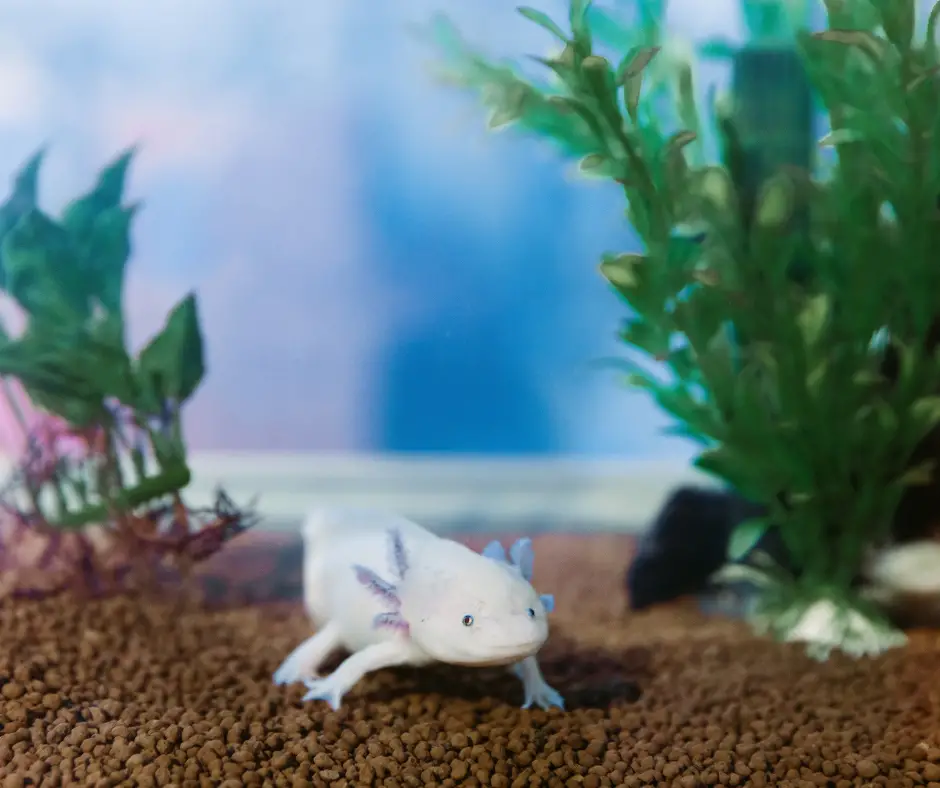
How to Set up Substrates for Axolotl Tank
Your axolotl’s aquarium is incomplete until you choose the right substrate. The way you set up substrates depends on factors such as the size of the tank and the type of substrate.
If you use only sand, the task will be quick and easy.
But if you want to use a mixture of substrates, make sure you have a pretty good idea of what you are putting into the tank and whether they will change the water parameters, particularly the pH level.
Rinse the substrate before you add it to the tank, otherwise the substrate can cause contamination.
The depth of the sand layer should not be more than a couple of inches. To prevent the buildup of anaerobic bacteria or gas, stir up the gas at least once a week.
Also read: 3 Best Axolotl Aquarium Setup Ideas
Conclusion
When it comes to setting up an axolotl tank, a substrate is not necessary. But leaving the tank floor bare is not a good idea either.
And it is important to be careful when choosing substrates for axolotl tanks because the wrong type of substrate can severely affect the health and well-being of axolotls.
We have discussed the best and worst substrates for axolotl tanks, and we believe now you have a good understanding of the available options. Assess the benefits and risks and choose the right substrate.
